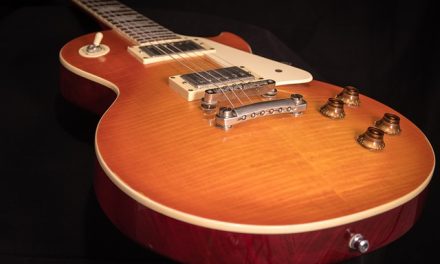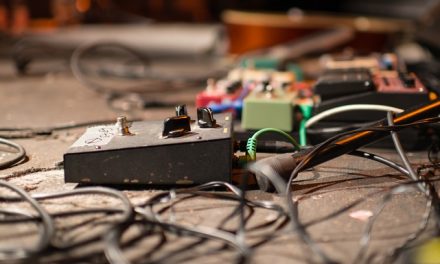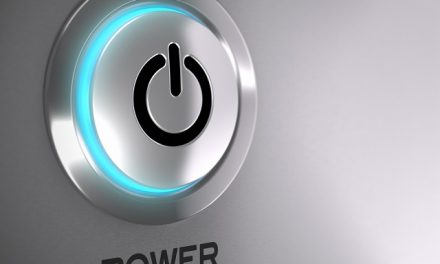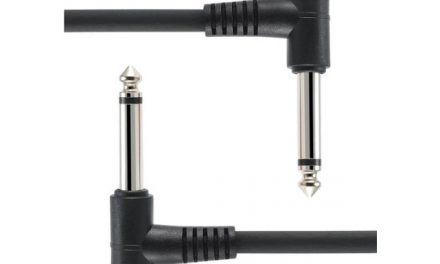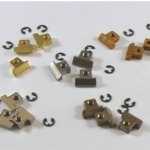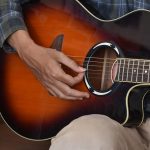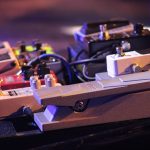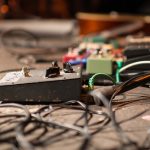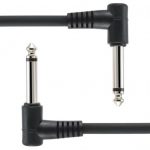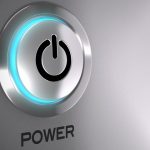Any links on this page that lead to products on Amazon are affiliate links and I earn a commission if you make a purchase. Thanks in advance for your support!
How To Choose An Effects Pedal Board
Pedal boards are pretty straightforward, but it’s important to learn the basics before buying one. Learning how to choose an effects pedal board comes down to 1) knowing what to look for, and 2) understanding what the less desirable features are so you can avoid them.
Ultimately, choosing a pedalboard for guitar or bass comes down to one thing: making it easy to get great tone whenever you need it!
A lot of what makes a guitarist’s unique tone is a combination of their playing style plus their guitar, amp, and effects. Think of Jimi Hendrix, Brian May, John Mayer, or Matthew Bellamy.
Sometimes you can easily hear the effects they are using, like delay or chorus; other times the effects are much more subtle.
Since effects are likely a significant part of your sound, a well-organized pedalboard makes it easy to create your unique sound quickly and efficiently, whether onstage or in the studio
Let’s dive into the details on how to pick a pedalboard and some pedal board buying tips!
Check out my complete series of pedal board articles:
Table of Contents
What Is A Pedal Board?
Since a lot of beginning guitarists and bassists aren’t yet hip to pedal boards, let’s start with the basics.
A pedal board is simply a platform made of wood or metal that holds all your effect pedals. All your effects are connected with patch cables and ready to go at all times. All you need to do is plug in your guitar or bass and your amp and play.
The simplest ones are very basic – just a piece of wood or metal. Effects pedals are usually fastened to the board with Velcro or cable ties.
More professional pedal boards add functions like angled board platforms, a power supply that powers the pedals, cable management features that hide messy cables, and heavy-duty travel cases.
Why Use A Pedalboard?
If you have more than a couple of effects pedals, a pedalboard is a must, because:
- All your effects are in one place, connected in the right order, and ready to go within a couple of minutes
For gigging and studio musicians, time is money. If you’ve dealt with the hassle of unpacking a bag of pedals and cables and trying to connect everything quickly in 10 minutes before a gig starts, you’ll appreciate a pedalboard.
You can literally just take off the lid, plug in your guitar and amp, and you’re set!
All your pedals will be connected in the right order, with the right cables, which makes a huge difference in the quality of your sound. (Check out this article to learn how to set up your pedal board)
- All your pedal settings remain as you set them and don’t get knocked around when traveling
A big plus is that your effects are locked down in a case or carrying bag so your effect settings won’t get knocked and changed by accident.
I played in a band once where we had a very short amount of time to get our equipment up and running. In the rush, my delay pedal got hit and the Feedback setting ended up at maximum. When the show started and I turned on my guitar, I was hit with a wall of feedback. It took me a couple of minutes to figure out what happened, but it was embarrassing (and unprofessional) to be one stage fiddling with my gear while the rest of the band played on!
- Your pedals and cables will last longer
You also avoid damage to your pedals and cables from carrying them around in backpacks or other light bags from gig to gig.
Cables especially suffer from constant unplugging and plugging in. Having everything connected and protected in a case makes everything last longer, costing you less money in the long run.
Pedal Board Buying Guide: How To Choose An Effects Pedal Board
Let’s go over some of the ins and outs of choosing a pedalboard.
Pedalboard Sizes
Pedalboards come in different sizes, the most common being:
- Nano (approx. 14” x 6”)
- Small (approx. 16” x 7”)
- Medium (approx. 24” x 10”)
- Large (approx. 30” x 15”)
However, there isn’t any standardization of sizes. One manufacturer small size may be another one’s medium size. It’s probably easiest to judge the real size of a pedal board by seeing a picture of it filled with pedals.
And, a pedal board’s size is influenced based on the number of rails it has.
What Are Pedalboard Rails?
Most pedal boards are designed with rails (horizontal slats) and not one solid piece of material.
Here’s a 4-rail pedalboard:
Pedals are attached to the rails usually with Velcro or substitute (you’ll frequently read about “hook-and-loop” which is a generic form of Velcro).
The more slats, the more pedalboards it can accommodate (or larger effects pedals it can fit).
5-rail pedalboards are the largest and provide lots of room for power supplies, a bypass switcher, and other goodies, and of course, more pedals!
The reason for the rails is that cables can be run under the rails and hidden underneath the pedal board, making the whole thing look neat and tidy.
In terms of number of pedals:
- Nano pedal boards (1-2 rails) can usually fit 1 to 4 standard-size pedals.
- Small pedal boards (1-2 rails) can usually fit 1 to 5 standard-size pedals.
- Medium pedal boards (3-4 rails) can usually fit 6 to 10 standard-size pedals.
- Large pedal boards (4-5 rails) can usually fit 10 or more standard-size pedals.
Pro Tip
Larger size pedals like volume pedals, wah pedals or loopers can be double width or double length, so be sure to factor that in when determining which size you need. Also, make sure the pedal board can accommodate taller pedals; some nano sizes won’t fit them.
Pro Tip
Look to get one a little larger than what you’ll need right now so you’ll have room to grow. Pedals can become an obsession, and many guitarists end up purchasing quite a few over the years. And there are some cool larger effects pedals like the and the Joyo JF-14 American Sound Effects Pedal that you may want to own, so make room for them in the future.
Angled or Flat Pedal Boards?
Pedalboards come with either an angled board area or a board that lays flat on the ground.
Choosing a pedalboard with an angled floor area is preferred by many guitarists, as the pedals in the back are raised and more comfortable to access.
A flat board can work fine if your pedals are all in one row, but they are more difficult to use if you have multiple rows of effects.
Also, some boards are built into a case (Boss makes these type of pedal boards) and flat models will sometimes have a lip you need to get your foot over to use.
Pedalboard Carrying Bag/ Soft Case vs. Hard Case?
Many lower-priced pedalboards only come with a soft case, carrying bag or backpack. More expensive models come with a hard-shell case.
Soft cases are convenient as they are lightweight and easy to carry around.
Hard-shell cases provide more protection against damage but are heavier and take up more space. For touring/ traveling musicians, a hard-shell case is a must, but large pedal boards may trigger weight restriction when traveling by air, while a travel bag or soft case can frequently be carried on as a carry-on item.
TSA Travel Notes: Taking Your Pedal Board On The Road
If you plan to travel by air with your pedalboard frequently, then getting a smaller size is essential if you want to be able to bring it as a carry-on.
Current TSA size restriction for carry-ons is 22” x 14” x 9”.
Multi-Effect Pedals vs. Individual Stompboxes
As with many things in life, you have lots of options when it comes to buying a pedal board. One of your first decisions is whether to buy a multi-effects unit or buy a pedalboard that you fill with your own pedals.
Many manufacturers make multi-effect pedal combos with lots of effects in one package. The and Zoom G3Xn are two examples of multi-effects units.
While these can be a solid value and sound great, especially for budget-conscious guitarists, they come with some tradeoffs.
The main criticism is that all the effects are made by the same company, which can lead to a sameness of sound.
Plus, you’re limited with those effects and can’t swap them out for different ones.
And finally, while you could potentially chain one of these multi-effect units with other effects, you may run into issues with having your effects in a less than optimum order, leading to problems with noise, hiss or hum.
If you’re a guitarist or bassist who likes having more choices and options, buying a pedal board “blank slate” and putting in your favorites is the way to go. You can mix and match the best effects from different manufacturers, giving you more control over your sound.
Powered vs. Unpowered Pedalboards
Effects pedals are powered either by batteries or power supplies. Let’s explore the pros and cons of each power source.
Batteries
The majority of standard-size pedals use 9V batteries. The pros are that 9V batteries are inexpensive and can last quite a long time.
The main drawback is that you continually need to monitor your battery life and replace batteries often because when your battery dies, the pedal dies too.
Also, some pedal batteries drain when the input is left plugged in, so you have to remember to disconnect the cable after use. I’ve had to replace many a battery because I forgot to unplug it.
So, for gigging musicians or studio players, you risk either messing up a performance or ruining a great take when a pedal’s battery decides to quit. And, of course, a pedal always seems to die during the best take or performance!
Power Supplies
A power supply that can power all your pedals is the next choice.
The pros are that power supplies are reliable and ensure uninterrupted performance.
The cons are that they’re more expensive and you need to purchase one for your pedal board (unless you buy one that has a power supply already installed).
But for many players, the tradeoff is worth it.
First off, almost all battery-powered pedals can also operate with a power supply, and all power supplies will output 9V power.
Smaller power supply models will have outputs to power 2-4 pedals; larger ones can power up to 12 pedals.
So, my recommendation is to buy a power supply and make life easier!
To learn more about power supplies and pedal boards, including my top picks, please check out this article. There’s a What To Look For In A Power Supply after the reviews.
Powered Pedal Boards
Powered pedal boards are those that come with the power supply. I’ve written a separate article on this; please see the Things To Consider When Buying a Powered Pedal Board section after the reviews
Pedal Board Cables
Cables are a very important part of your pedal board setup. Check out this article – there’s a Patch Cables Buyers Guide after the reviews.
Pedalboard Manufacturers
There are quite a few manufacturers of pedalboards. Pedaltrain, Donner, Gator Cases, and Holeyboard are popular choices. The following are some highly-rated choices under $300:
Donner DB-3 Guitar Pedalboard Case
An inexpensive (well under $100) angled pedalboard with carrying bag.
Pedaltrain Classic 1 TC 22″x12.5″ Pedalboard with Tour Case (PT-CL1-TC)
Pro-level pedalboard with a 4-rail design. Comes with tour case.
Road Runner Pedal Board with Bag and Visual Sound 1 Spot Combo Pack
Small pedalboard with gig bag
GOKKO AUDIO GKB-52 Guitar Effects Pedal Board case 22″ x 12.6″ Pedalboard With Carrying Bag (Large)
Large size 4-rail pedalboard with carrying case
Holeyboard Dragonfly 3
Very cool expandable futuristic design
Wrap Up
That’s it! With all the info you’ve learned here, you should be able to choose a pedalboard that’s right for you! Please feel free to ask questions or leave comments below. Happy playing!
Check out my complete series of pedal board articles:


